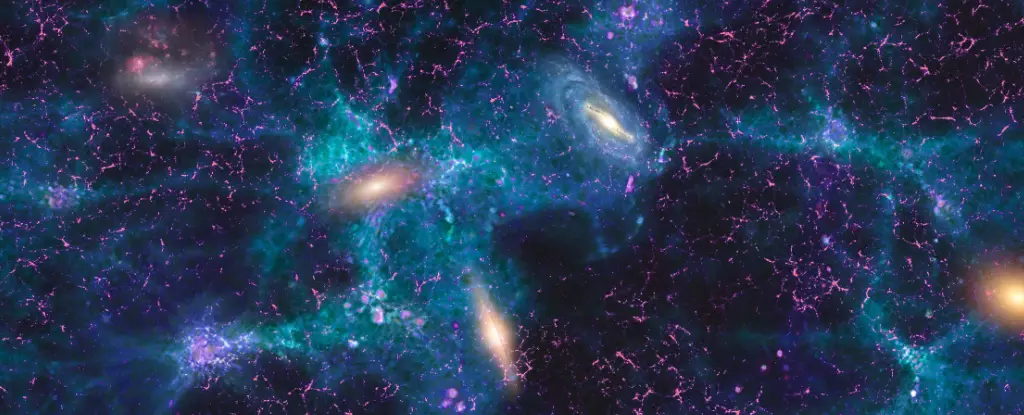Recent findings in astrophysics reveal a perplexing phenomenon: the universe appears to be expanding at a rate that current physical models struggle to articulate. Armed with precise measurements taken from a galaxy cluster situated over 300 million light-years away, scientists have noted that the seemingly endless expanse of galaxies is not behaving in a manner consistent with established theoretical frameworks. This research is a striking reminder that, although we have gleaned much about the cosmos, there remain numerous enigmas, particularly concerning the underlying mechanisms responsible for such relentless expansion.
At the heart of this mystery lies a series of complex interactions that span from quantum fields to gravitational forces, alongside a baffling version of energy known as “dark energy.” For nearly a century, the prevailing consensus among astronomers has classified the universe as initially being a dense melding of mass and energy, now transitioning into an ever-expanding landscape of galaxies adrift in a seemingly infinite void. The dynamics of this evolution hinge on concepts that are only partially understood—especially the competition between elusive forces that both push space apart and attract matter.
The current model posits a uniform dispersal of matter across the cosmos, intermingled with clumps that are both visible and obscured to our observation, pushed away in a predictable manner as encapsulated by the Hubble constant. To verify the accuracy of our cosmic understandings, astronomers have taken to measuring the velocities at which these clusters recede into the vastness.
The Discrepancy of Measurements
However, not all measurements agree on how quickly this relentless expansion occurs. Different methodologies yield divergent estimates of the Hubble constant, leading to a phenomenon referred to as a “tension” in cosmology. This unsettling discord has been emphasized recently by physicists like Dan Scolnic from Duke University, whose investigations into nearby galaxy clusters have brought this divide into sharper focus.
A crucial data set from the Dark Energy Spectroscopic Instrument (DESI) provided insights into measuring the relationship between stretched space and the distance to the Coma cluster—a colossal concentration of galaxies—yielding a new understanding of our expanding universe. The success of this measurement serves as a benchmark for elucidating distances to more remote cosmic bodies, thus establishing a measuring ladder that reaches farther into the universe.
Precision in Measurement and Its Implications
Scolnic’s team approached this problem critically, focusing on refining the methodology to ascertain a more precise distance to the Coma cluster—ultimately determining it to be 321 million light-years away. This result resided comfortably within the parameters of earlier estimates. By enhancing the confidence in distance calculations, they also refined estimations regarding the rate at which the fabric of space itself is expanding. Their latest numbers suggest a speed of 76.5 kilometers per second per megaparsec, a figure in alignment with other contemporary observations.
However, the significant conundrum manifests when juxtaposed against estimates derived from ancient cosmic light that emerged soon after the universe’s inception, which suggest a slower rate of 67.4 kilometers per second per megaparsec. This stark inconsistency remains one of the most contentious puzzles in modern cosmology, raising serious questions about the reliability of both measuring techniques.
The essence of our current dilemma lies in the hope that further refinements in measurement methodologies will either uncover fundamental errors in our assumptions or illuminate new physics that may better explain these discrepancies. The quest for answers has enveloped physicists in a whirlwind of inquiry, as they seek to navigate this critical juncture in our understanding of the universe.
As Scolnic indicates, the scientific community is now at a pivotal moment, testing the boundaries of models that have been in place for over two decades. This rigorous examination might not merely confirm or refute existing theories, but it holds the potential to redefine our perspective on the cosmos itself—a prospect that is as exhilarating as it is daunting.
In grappling with this cosmic riddle, scientists stand at the forefront of potential discoveries that offer the promise of rewriting the rules of astrophysics. The tension surrounding the expansion of the universe is not merely a technical issue; it presents an opportunity to deepen our comprehension of the cosmos and, possibly, our place within it. As researchers continue to probe these mysteries, each new revelation may unlock further questions, eternally fueling our insatiable curiosity about the grand design of the universe.

